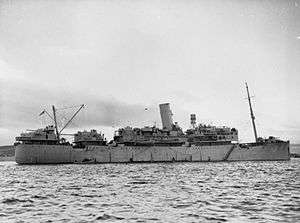HMS Cheshire
HMS Cheshire (F18), was a ship of the Royal Navy, named after the English county of Cheshire. Previously a passenger ship, she served as an armed merchant cruiser and troopship in World War II.
 HMS Cheshire, armed auxiliary cruiser and troopship | |
| History | |
|---|---|
| Name: | HMS Cheshire |
| Builder: | Fairfield Shipbuilding & Engineering Co Ltd, Govan, Glasgow |
| Launched: | 20 April 1927 |
| Completed: | July 1927 |
| Identification: | Pennant number F18 |
| Fate: | broken up at Newport, July 1957 |
| General characteristics | |
| Type: | Armed merchant cruiser |
| Tonnage: | 10,552 GRT |
She was torpedoed twice by U-boats but survived each and returned to service after extensive repairs.
Cheshire was used as a repatriation ship at war's end in 1945, and was returned to her owner in 1948. She was broken up at Newport in July 1957.
History
HMS Cheshire was launched in 1927 by Fairfield Shipbuilding & Engineering Co Ltd, Govan, Glasgow, 10,552 tons grt. She was completed in July that year for Bibby Brothers & Co, Liverpool as the motor passenger ship Cheshire. On 29 August 1939, she was requisitioned by the Admiralty and converted to the armed merchant cruiser HMS Cheshire (F 18).
She was struck by one torpedo from U-137 on 14 October 1940, northwest of Ireland (55°13′N 13°02′W). A total of 220 crew members were taken off by the Canadian destroyer Skeena. Cheshire was towed to Belfast Lough and beached. Later she was taken to Liverpool for repairs lasting six months.
She was torpedoed again on 18 August 1942 at 41°30′N 19°49′W by U-214, which fired four torpedoes at the convoy SL 118 at 18:52. Detonations were heard 2 minutes 27 seconds, 3 minutes 10 seconds, 4 minutes 31 seconds and 4 minutes 37 seconds later, along with the sounds of three ships breaking up. U-214 claimed the sinking of four ships totaling 20,000 grt. In reality one torpedo had damaged Cheshire, another sank Hatarana and two torpedoes sank Balingkar.[1]
On 9 June 1943, she was returned to her owner and used by the Ministry of War Transport as troop transport.
She also survived a U-boat attack on a small convoy of troopships transiting the English Channel from Southampton, England to Cherbourg, France, containing just herself and SS Leopoldville. While protected by an escort of four destroyers steaming in a diamond-shaped screen surrounding the transports, Leopoldville was torpedoed and sunk by U-486 on 24 December 1944. Over 800 men were killed including 763 U.S. soldiers headed for deployment in the Battle of the Bulge.[2]
During Cheshire's very next run, delivering the U.S. 289th Engineer Combat Battalion to Le Havre from Southampton between 28 and 31 December 1944, a troop transport in convoy on the same route, SS Empire Javelin was lost to a possible mine on 28 December.,[3][4]
Units transported
Units transported during World War II included:
- 66th Infantry, 263rd regiment
- 83rd Infantry, 329th regiment
- 289th Engineer Combat Battalion, departed Southampton, 28 December 1944, on HMS Cheshire's next passage following SS Leopoldville sinking, arrived LeHavre, France, 31 December 1944,[5] the same run which saw the sinking of SS Empire Javelin on 28 December.
Post-war
Cheshire was used as a repatriation ship in 1945 and returned to the owner on 5 October 1948. She was broken up at Newport, Wales in July 1957.
References
- Helgason, Guðmundur. "HMS Cheshire (F 18)". German U-boats of WWII - uboat.net.
- Helgason, Guðmundur. "The Sinking of SS Léopoldville". German U-boats of WWII - uboat.net. Retrieved 17 January 2011.
- Schoichet's account of the sinking of Empire Javelin: "Noon of December 28 found us approaching the half way mark in the channel...Suddenly, without warning, the whole world erupted."
- Helgason, Guðmundur. "Empire Javelin". German U-boats of WWII - uboat.net.
- Passage dates per "Travels of the 289th"
Bibliography
- Osborne, Richard; Spong, Harry & Grover, Tom (2007). Armed Merchant Cruisers 1878–1945. Windsor, UK: World Warship Society. ISBN 978-0-9543310-8-5.